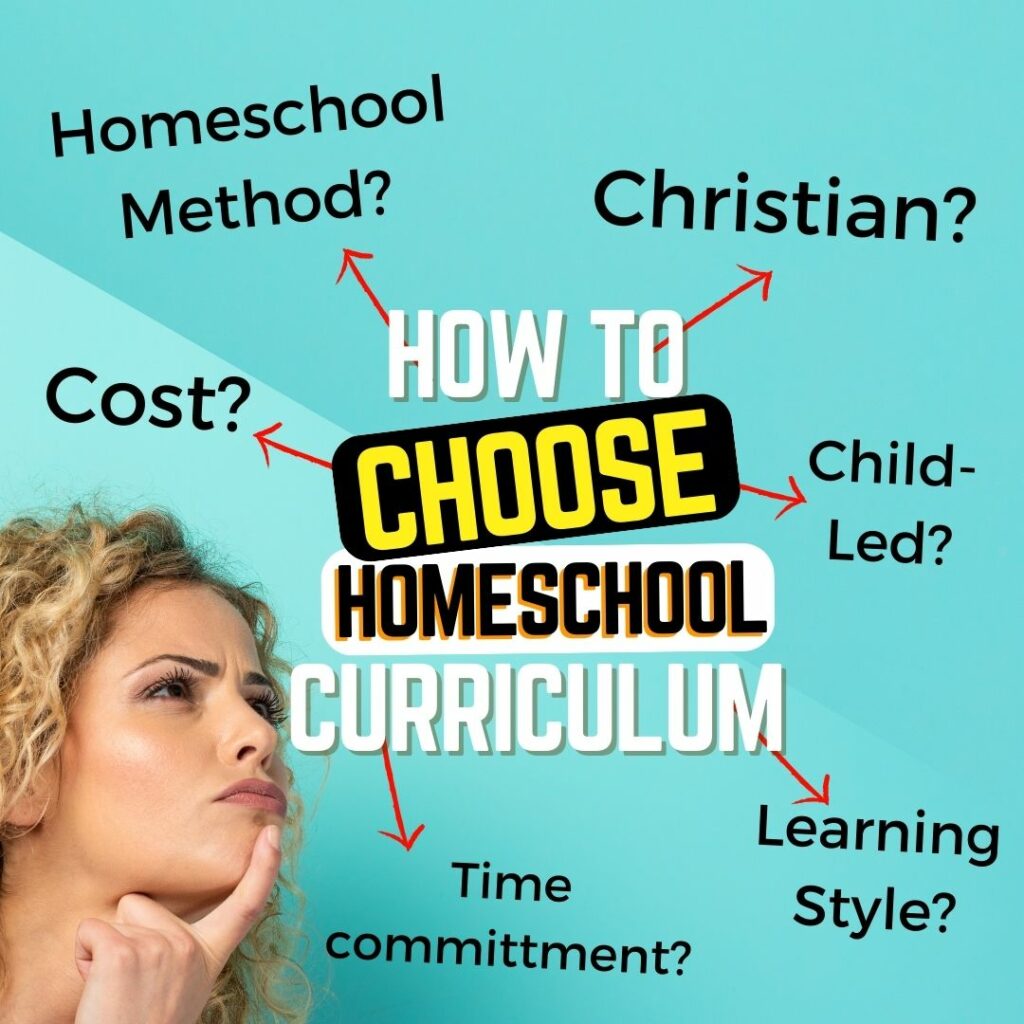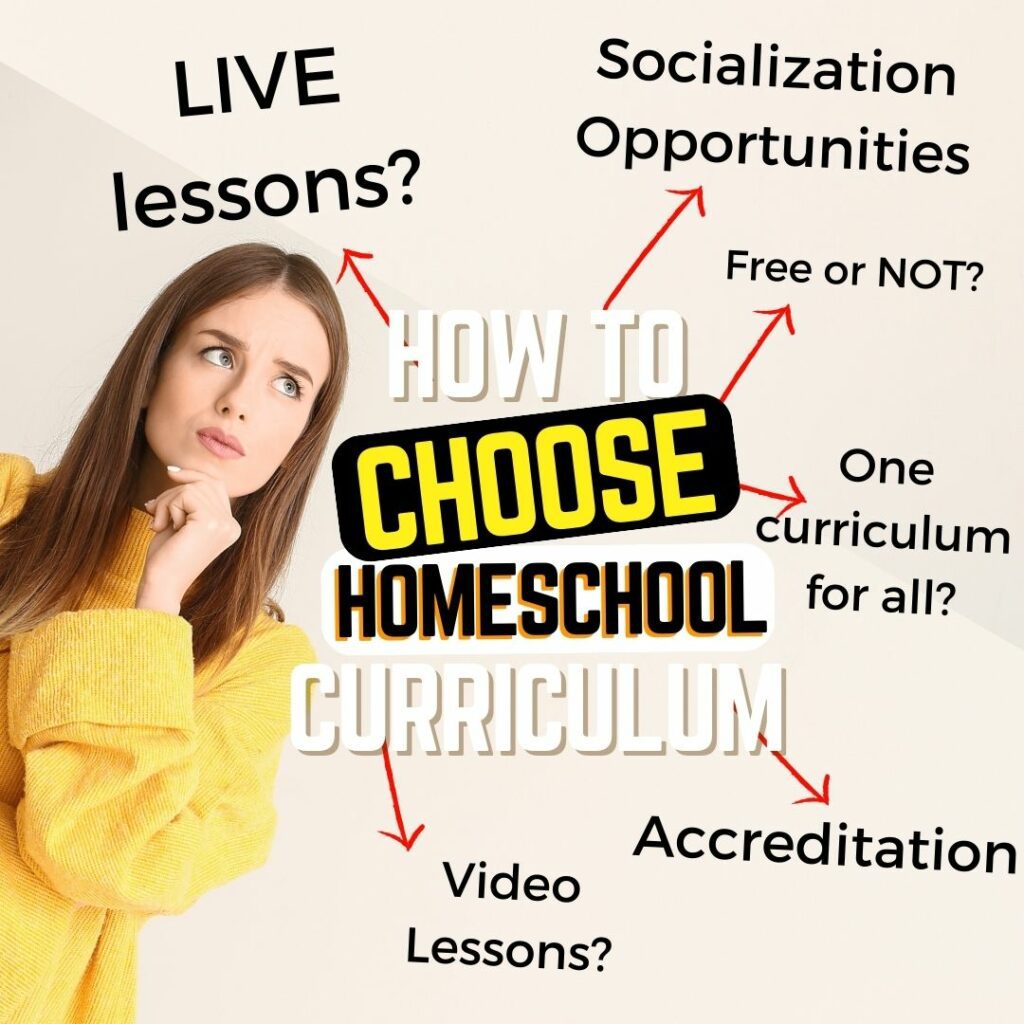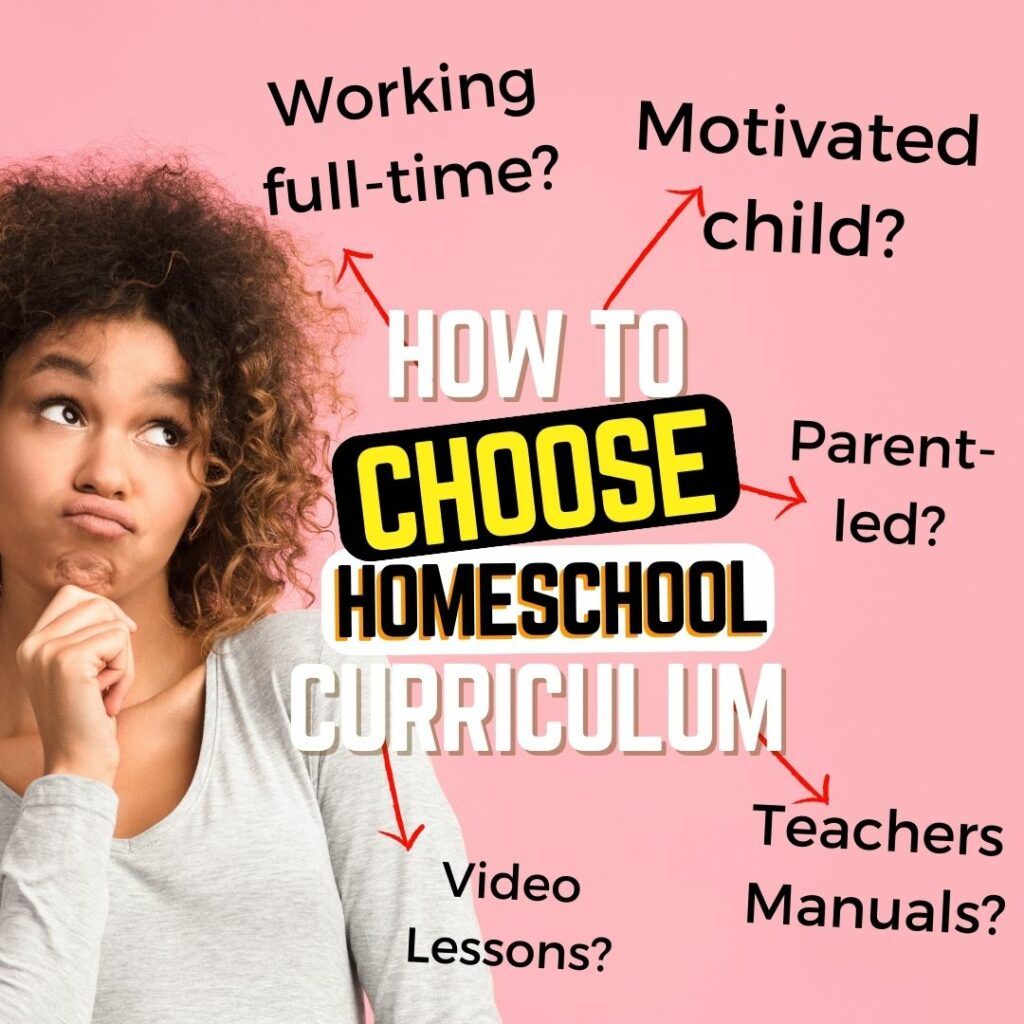Starting to homeschool? Instead of asking, “What’s the best curriculum?” think about what suits you (and your children) best. Finding the perfect curriculum is key whether you’re a newbie or leveling up for high school. Let’s make it simple and exciting!

I hope you enjoy reading this blog post. If you want to do my course on how to homeschool, click here.
To pinpoint the best homeschool curriculum for your family, reflect on:
- Your family (you and your child)
- Your budget
- Your convictions
A perfect match will consider all three aspects. This guide will assist you in assessing these factors and determining if a homeschool curriculum suits your unique needs.

Affiliate links are used in this post. This helps support us at no extra cost to you!
Choosing a Curriculum Based on Your CHILD
Kids vary in age, developmental stages, learning styles, and interests, making the choice of a homeschool curriculum a nuanced decision.
For instance, if you’re dealing with preschoolers or contemplating a Kindergarten homeschool curriculum, you’ll want a program designed for their specific developmental needs:
- Creative Kids Virtual Preschool is excellent for Preschool
- BJU Press does a beautiful job of Kindergarten
If you have an active, outdoorsy child, you might look for homeschooling resources catering to their energetic nature. Oak Meadow, which is very outdoorsy and nature-oriented, might suit your children best.
Also, if your child struggles with math, finding the right homeschool math curriculum becomes crucial. Maybe something with games will suit them. Or Saxon Math is also a favorite.
Consider Their Learning Styles
Consider learning styles, too. Some children thrive when they can create and build in a hands-on manner; others prefer reading or engaging in conversations.
Delve into learning styles like:
- visual,
- auditory, and
- kinesthetic,
Explore whether your child leans towards a right-brain learning approach when selecting a curriculum.
This tailored approach ensures that your homeschooling journey resonates with your child’s individuality.
Consider Their Interests
Many traditional programs can be less engaging for children – quite frankly, boring.
Interest-led learning, however, serves as a breath of fresh air for kids with a strong passion or those who find traditional schoolwork uninspiring.
This new approach helps you to choose resources that fascinate your children, offering the flexibility to explore beyond the confines of a formal homeschool curriculum.
Some great curricula that really aim to teach through interests are:
- Schoolhouse Teachers (Christian)
- Compass Classroom (Christian)
- Discover (secular),
- Elephango (secular)
Think About Their Age
Grade Levels: Explore how grade levels factor into homeschooling. Homeschooled children often learn at various grade levels for different subjects, providing the flexibility to cater to their needs rather than strictly adhering to conventional grade expectations.
These are good options for choosing a homeschool curriculum by grade:
- Primary School – BJU Press, Schoolhouse Teachers, Generations
- Middle School – Apologia, Notgrass
- High School – Compass Classroom, True North Homeschool Academy
High Schoolers and College?
Also, consider your high schooler’s future path, whether it involves college, a vocation, or entrepreneurship.
Remember that you may not need a homeschool curriculum if your child wants to:
- graduate early and enter college or a trade,
- start entrepreneurship (although they might like training for entrepreneurship)
- quit traditional schooling early and take up adult courses (Masterclass is excellent here)
But I have also argued about the benefits of not doing college at all for these reasons.

Choosing a Curriculum Based on PARENTS
When considering how to choose a curriculum for homeschool, it’s imperative to think about YOU, the parent. Because while a curriculum might suit a child if it doesn’t suit you, it won’t work.
Consider Your Spare Time
Many people think homeschooling takes all day, but in reality, homeschoolers typically spend only two to three hours on formal schooling and often achieve higher test scores than traditionally schooled counterparts.
Think about how much time you have for homeschooling. Some people might need to get help because they have limited time, health issues, or other reasons.
Balancing Work and Homeschooling:
If you work full-time and homeschool, choose a curriculum that doesn’t demand your presence for long hours daily, allowing flexibility for both work and teaching.
A few good options here are:
- Generations (Christian, boxed workbooks)
- IXL (secular, online)
- Monarch (Christian, online)
- Ignite Christian Academy (Christian, online, accredited)
Remember, simplicity often leads to success in this balancing act!
Your Education Philosophy
Decide if you have a specific way of thinking about education or are okay with figuring it out as you go.
Many people just want something simple like a mastery-based program kids can do in a self-paced manner or something that’s an open-and-go homeschool curriculum.
Others want to follow a specific homeschool method and choose a curriculum that follows these methods (you can do a quiz here to decide what homeschool method you most prefer):
- Classical homeschool programs
- Charlotte Mason programs
- Traditional curricula
- Unit Studies programs
- Eclectic options
The two most popular homeschool philosophies are the Classical and Charlotte Mason methods.
Hands-On or Not
Figure out if you are okay with doing hands-on activities. Some people enjoy teaching kids through doing things, while others prefer less…glue.
If you’re thinking about how to choose a homeschool math curriculum that’s hands-on, check out Right Start Math. Or, if you’re considering a reading curriculum, look at All About Reading and Spelling.
Otherwise, again, I love BJU Press as it’s pretty hands-on but not in an overwhelming way.
Navigating High School
High school can be a daunting time to homeschool. But not if you’ve chosen the right curriculum.
Check if you can help your child through high school. High school homeschooling can be challenging, so make sure you can provide the needed support.
But, if you don’t feel you’re up to it, you can also get your children into an accredited program. This is essentially an online school and completely takes the weight off your shoulders.
Also, remember some programs are easier than others to implement! (Some children can do the curriculum themselves, especially with a self-paced homeschool curriculum.)
Consultations or Not?
Some want to do a homeschool curriculum consultation before they get a curriculum.
Many companies offer this service, and some do it for free, such as Veritas Press, which produces a classical Christian curriculum. You can take advantage of their free consultation here.

Choosing a Homeschool Curriculum Based on CIRCUMSTANCES
Every family can make homeschooling work, but it’s essential to tailor your approach based on your unique situation. Consider these scenarios when choosing your curriculum:
Starting from Scratch
If you’ve always wanted to homeschool and your kids have never been to school, you’re crafting an educational journey from the ground up.
Problem-Solving
Homeschooling might be your solution to a specific school-related problem. Whether you’re an accidental homeschooler or planning a short-term stint, adapt your curriculum to address immediate needs.
Special Needs
Homeschooling could be a response to a child labeled with ADD/ADHD or one deemed ahead or behind by public education standards. Tailor your curriculum to accommodate unique learning styles.
Perhaps your child has autism and needs a homeschool curriculum for autism (see video below). Homeschooling is amazing at accommodating children with special needs or giftings.
Location
Sometimes, governments have laws that require you to follow a particular syllabus. If so, you can look up specific homeschool curricula that will suit specific countries like:
But you can also modify a curriculum from another country to suit your homeschool laws like I do.
Balancing Work and Family
Managing homeschooling while working and tending to a large family requires a curriculum that fits your busy lifestyle and diverse needs.
Here, you can consider a program that suits large families – a family-style homeschool curriculum.
Overcoming Limitations
If you face constraints in time, money, technology, or partner expectations, choose a curriculum that aligns with your available resources and circumstances.
Future Preparation
Consider homeschooling to meet specific requirements or to prepare your child for future educational or career possibilities.
Budget-Friendly Options
If finances are tight and the cost of homeschooling looks steep, explore budget-friendly homeschooling options, including free curriculum choices. Easy Peasy All-in-One is one of the best free options around today.
Remember that you can even save by buying used homeschool curricula from various sources.
You can also look at cheap homeschool curricula that won’t break the bank.
Schoolhouse Teachers is one of the best-priced programs around. You can get curriculum for:
- ALL your family and
- ALL subjects,
- including the most extensive range of electives I’ve ever seen.
Check them out here.
Diploma Concerns and Accreditation
Many parents are concerned their children won’t attend college if they homeschool. However, they will be relieved that colleges accept homeschool diplomas written by homeschool parents.
This said, many parents prefer an accredited homeschool curriculum that produces a high school diploma from an accredited school.
If that’s you, check out these accredited homeschool curriculum options:
Also, keep in mind that there are many pathways to university. Here are a few routes my brothers and I took to university.
Cooperative Learning
You might also like to consider whether your child wants to learn in a co-op. There are many options here, including:
- True North Homeschool Academy (LIVE, online lessons with small class sizes)
- Classical Conversations
Some love homeschool co-ops, and others aren’t fans. You’ve got to try them to figure out who you are.

Choosing the Right Curriculum
When deciding on a homeschool curriculum, focus on these things:
Content
Look at what topics the curriculum covers. Many programs are Bible-based or secular in nature.
Also, ensure it aligns with your child’s expected level, like a second-grade math curriculum covering appropriate subjects.
Approach
Consider whether you prefer a structured curriculum using textbooks or one based on:
- Charlotte Mason living books (Heart of Dakota does this) or
- classical great books (Memoria Press homeschool does this).
Different homeschool styles match various curricula.
Delivery
Also, explore the advantages and disadvantages of online all-in-one programs versus learning through activities, projects, or creative methods like lapbooks or notebooks.
If you want to get an excellent feel for a curriculum, you can visit curriculum vendors at homeschool conventions.
This helps you judge whether the materials will work. It also involves your children in the decision-making process.
Choosing a Homeschool Curriculum by SUBJECT
Some parents prefer to shop for curricula by subject. If so, you can look at various options here:
- Math curriculum programs
- History programs
- Art curricula
- Science curricula or Creation Science programs
- Latin programs
- Homeschool Economics programs
- Music homeschool programs
- Foreign Languages curriculum
- Reading curricula
- Geography homeschool curriculum
This way, you can find something that targets each subject.
Dealing with Conflicting Priorities
Sometimes, finding the right fit is challenging due to competing priorities. You might like one that’s expensive, while your child prefers another with too many crafts, like My Father’s World (although you can skip these in this curriculum).
Balancing multiple children adds complexity, but unit studies can be flexible for varying ages.
That’s because unit studies help you teach all your family simultaneously.
Be open to adjustments as you navigate these challenges.
It’s common for homeschool parents to reassess their curriculum choices shortly after starting, and that’s okay.
Embrace the idea that changes may be necessary for homeschooling success.
Use NO Curriculum
Did you know some people don’t use formal homeschool curriculum?
Instead, they choose various non-curricular resources.
Veteran homeschoolers suggest “deschooling” before deciding on curriculum, while some delay formal lessons until later.
Unschooling, which some see as perpetual deschooling, is another option, emphasizing learning without a formal curriculum.
If you’re doing this, check out the following homeschool booklist:
REMEMBER: Homeschool is NOT ‘School at Home’
Homeschooling doesn’t have to mimic traditional school methods.
Opting for a flexible curriculum is often recommended – otherwise, you can severely burn out. Because let’s face it – you don’t have the time a schoolteacher has!
Remember, choosing a curriculum is just one part of homeschooling. Check out How to Start Homeschooling for basic steps to get started!
God bless you on your homeschool journey!



